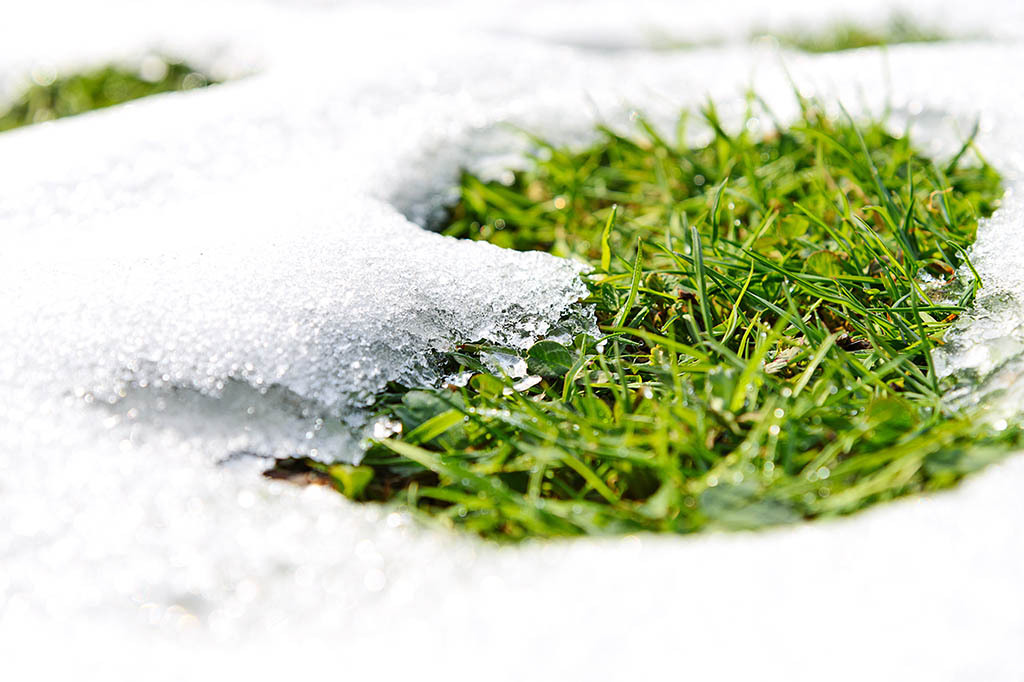Preparing Your Lawn for Winter
Everyone knows a beautiful lawn requires care and attention in the summer – mowing, fertilization and watering. But do you know how to properly maintain your lawn in the winter?
Many factors during the dormant season affect the health and strength of your grass. If you want to keep your turf looking good (and who doesn’t?), you need to know how the right care, the right conditions and the right grass height affect how lush and green your lawn looks when spring rolls around again.
Get ready to learn the answers to: when does grass stop growing, how short to cut grass before winter, how to keep grass green in winter and more!
Does grass grow in the winter?
While some people seem to think the last mow of the season is not until the snow flies, others stop mowing earlier in the fall. When does grass stop growing? Does grass grow in the winter?
Grass in winter actually does grow, if the temperatures are right. In fact, grass will keep growing if the daytime temperatures stay above 55 degrees. In Ohio, depending on the year, that can extend into November or even later.
As fall wears on, the grass slows its growth and, eventually, stops growing altogether. But keep mowing until the grass is dormant. Once it’s truly dormant, and daytime temperatures stop rising above 50 degrees, give your grass a break from cuts, to prepare it for the long winter months.
What is the best grass height for winter?
When you have determined it’s truly the last mow of the season, you need to decide what height to cut your grass. Is it better to leave your lawn long or short before the winter? Is four inches too tall for grass? Is two inches too short?
It’s very important to cut back your grass before winter, in the case of Northern grasses, such as Kentucky Blue Grass, tall fescue and perennial rye grass. These types of grasses, common in Northeast Ohio, shouldn’t be left long during cold, snowy winter months. It’s much better to keep your grass short for winter.
Why is short grass better for winter?
There are many reasons long grass is not the best idea during winter. Long grass provides a meal for insects and small animals, such as voles, who will feed on the grass under snow cover throughout the winter season. This puts your lawn at risk of disease, providing an opportune place for mold and bacteria to take over. You might put your grass at risk for disease, such as snow mold.
Snow mold is caused by excessive water, thatch, debris, and leaves, all of which keep the grass overly wet. The cold and damp then provides a breeding ground for disease. Cutting your grasses back for winter helps avoid contributing to these conditions. (Make sure to also clear out extra leaves and debris before the snow starts to fly.)
Ideal grass height for winter?
Choosing the right grass height for winter is an important decision. An improper cut can cause stress to the plant. If your cut your grass too short, the cold weather can stress or damage the roots or leaves. If your grass is too long, it’s at risk for disease.
The ideal grass height for winter is between 2 inches and 2.5 inches. This keeps grass short enough to resist disease spread, but not so short that it becomes overly stressed by cold temperatures.
As temperatures decrease and growth slows down, you can gradually reduce the height of your blades when mowing until they reach this optimal length. Make sure the last few lawn trims of the fall season are at this short height.
How to keep your lawn green in winter
Once you’ve fine-tuned the proper height to cut your grass for winter, you may wonder whether you should fertilize, too. After all, the extreme weather conditions of winter take a toll on your lawn. But since your grass goes dormant when the freezing cold temperatures arrive, it’s best to do your prep before that happens.
This is why fall is the best time to fertilize grass. The plant is actively growing its root system, making it a peak growing season.
Fertilize your lawn in the fall to keeps things green and healthy. A little advance treatment will help your yard maintain its color and vibrancy until growing season begins again in the spring.
The best grass fertilizer for winter
Applying a winter fertilizer in the fall is appropriate for cool-season grasses such as fescue or bluegrass, but warm-season grasses like Bermuda and zoysia do better with just a spring fertilizer. You can put down a winterizer in November for cool-season grasses and pick back up with fertilizing in the spring when temps start to rise again and the root system resumes growth.
Want to maintain a healthy green lawn?
Proper care, feeding, and cutting of your grass for the winter will ensure you maintain a lush and healthy lawn all year long. For more details on winter lawn care or to sign up for a lawn care package where we do the work for you, contact GrassMaster today.

